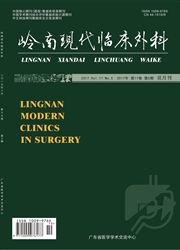

 中文摘要:
中文摘要:
目的 探讨人工全髋和半髋关节置换治疗老年移位股骨颈骨折临床效果.方法 选择我院2008年2月至2010年2月股骨颈股骨老年患者共120例,上述患者分为两组,观察组和对照组.观察组和对照组均在全身麻醉或者持续硬膜外麻醉下实施手术,健侧卧位,后侧入路,采用关节置换常规技术,观察组植入人工半髋关节生物型假体,对照组植入人工全髋关节生物型假体.记录两组患者手术时间、术中出血量和术后引流情况;两组患者随访结束时根据髋关节Harris评分对髋关节功能进行评分.结果 观察组在手术时间、术中出血量、术后引流量均有明显的优势,与对照组比较,两者差异有统计学意义(P<0.05);观察组Harris评分与对照组比较,差异无统计学意义(P>0.05).结论 人工全髋和半髋关节置换治疗老年移位股骨颈骨折,均具有良好疗效,但后者手术时间短、术中出血少,手术创伤小,并发症少.
 英文摘要:
英文摘要:
Objective To investigate the clinical effect of artificial replacement of the whole hip joint and partial hip joint for the treatment of displaced fracture of femoral neck in elderly patients. Methods A total of 120 elderly patients with femoral neck fracture from Feb. 2008 to Feb. 2010 were divided into observation group and control group. Both groups underwent operation with general anesthesia or continuous epidural anesthesia. The patients in observation group were implanted artificial biotype prosthesis of partial hip joint, while those in control group were implanted artificial biotype prosthesis of the whole hip joint. The operation time, bleeding volume and postoperative drainage of two groups were recorded. The function of hip joint was assessed by Harris hip score after follow-up completed. Results The patients in observation group showed better effects on operation time, bleeding volume and postoperative drainage than controls. The differences in two groups had statistical significance (P〈0.05). The difference of Harris scores of two groups had no statistical significance (P〉0.05). Conclusions Both artificial replacement of the whole hip joint and partial hip joint have good effect on the treatment of displaced fracture of femoral neck in elderly patients, but the latter has shorter operation time, less bleeding volume, smaller trauma, and less complications.
 同期刊论文项目
同期刊论文项目
 同项目期刊论文
同项目期刊论文
 期刊信息
期刊信息
